Elmo
Elmo Sisters was founded in Pittsburgh by Margaret Dryden [1876-1957] (née Margaret McCann, a.k.a. Margaret Elmo, and Margaret Moore) and Mary Haley [1881-1953] (née Mary McCann, a.k.a Mary Elmo, and Mary Henderson). The women were sisters, born and raised in Pennsylvania by their parents, William J. McCann [1855-1941] and Mary McCann, née McGuire [1864-1923] along with their five younger brothers.
Elmo trademarks put the date for the establishment of Elmo Sisters as 1908 but Elmo cosmetics, such as Elmo Violet Talcum and Elmo Triple Extracts, were being advertised in 1907. This suggests that Margaret, who owned most of Elmo Sisters, may have been in the beauty business earlier than this and was later joined by her older sister Mary when Elmo Sisters was created.
Why Elmo was selected as the business name is also a mystery. However, both sisters used Elmo as an alias on numerous occasions as did their brother, Mark McCann [1893-1956], after he joined the firm.
The 1908 Pittsburgh City Directory puts Elmo Sisters at 3613 Boquet Bell, a street that no longer appears to exist. The 1910 Pittsburgh City Directory lists the two sisters as Mary and Margaret Elmo, both living at the Hotel Lincoln. The business was now at 408 Pennsylvania Avenue, Pittsburgh but manufacturing was taking place at 136 West Randolph Street, Chicago. By 1912, Elmo had moved to 114 Thirteenth Street, Philadelphia and the following year it incorporated in Philadelphia (capital US$25,000) with Margaret as president and Mary as secretary-treasurer.
As it grew in size, Elmo made a number of moves within Philadelphia. It was at 1020-1024 Filbert Street in 1919 but had moved to 1027-1033 Callowhill Street by 1925. In 1928, Elmo relocated to a new home on the corner of Hunting Park Avenue and 21st Street where it stayed for many years. By this time it also had branches in Los Angeles, California and Dallas, Texas.
Until the 1930s, the sisters largely restricted sales of their products to department stores and most of their advertising was done cooperatively with these stores. The company also relied more on in-store demonstrators than advertising with many newspaper placements simply announcing the arrival of an Elmo representative.

Above: 1909 Elmo Sisters demonstration announcement, placed in an advertisement for the Lippincott & Co. department store in Wilmington, Delaware.
Elmo was an early adopter of demonstrators and this would bring it into conflict with the American Federal Trade Commission (FTC) following the passage of the Robinson-Patman Act in 1936 which forbid sellers from providing services, such as demonstrators, only to some customers.
Products
There is some information on Elmo products sold though to 1930 but very little on when new lines were introduced. Products were initially packaged displaying an image of the Margaret Dryden surrounded by a horseshoe trademark.

Above: 1914 Elmo product packaging.
However, when the packaging was updated in the 1920s, the earlier trademark was replaced by an ornate rendition of the word Elmo.
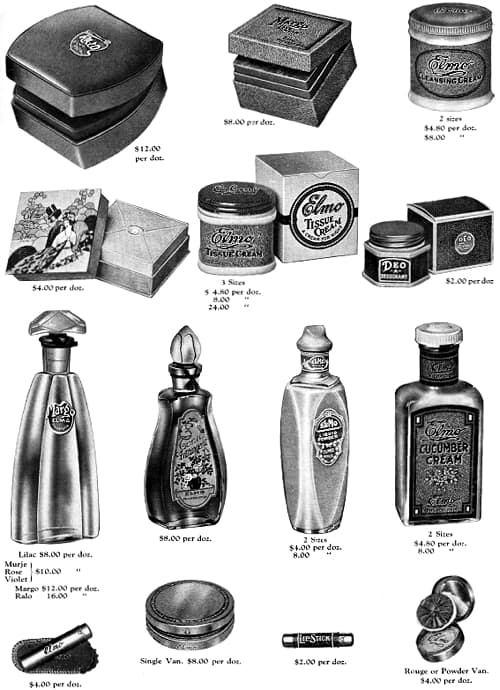
Above: 1923 Elmo product packaging.
Skin-care
Skin-care products available by 1930 included Elmo Cleansing Cream, Tonic Astringent, Vanishing Cream, Tissue Builder, and Cucumber Cream, the later being a lotion. I assume the Elmo Cleansing Cream was a type of cold cream; the Elmo Tissue Builder was advertised as a cleanser and skin food; and the Elmo Cucumber Cream was a type of vanishing cream containing a mild bleach. Like the Elmo Vanishing Cream, the Cucumber Cream could be used as a powder base but it was also promoted as a hand cream.
Cleansing Cream: “Softens the dust and dirt collected in the pores.”
Tonic Astringent: “[C]ontaining healing herbs, contracts the pores, tones and braces the tissues and muscles, and freshens the skin.”
Tissue Builder: “[P]revents the skin from getting dry and rough; prevents the forming of lines and wrinkles.”
Cucumber Cream: “A perfect foundation for powder, containing no grease or oil—a thorough bleach for tan, freckles and sun burn.”
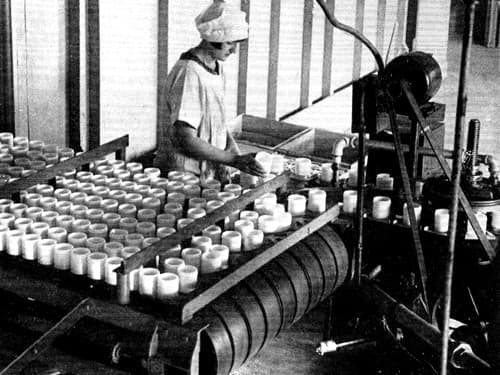
Above: 1930 Filling jars with Elmo Cucumber Cream.
In 1922, Elmo debuted a clay pack, a popular cosmetics of the 1920s with versions developed by a number of cosmetic companies. I have no record of what the Elmo clay mask was originally called but later in the decade it was referred to as the Elmo Margo Masque, presumably because it was scented with the Margo fragrance, introduced in 1915.
See also: Complexion Clays and the A.M.A
Make-up
Elmo sold a number of make-up items early on including a face powder, rouge and lipstick.
Lipstick and rouge
Elmo’s first rouge was a liquid (1909) which seems to have come in a single shade, possibly called Sherry Wine, with Elmo Dry Rouge (1910), a compressed powder, and Elmo Cream Rouge (1925) added later. I have no details on shade ranges of these later additions when they debuted.
Liquid Rouge: “[A] natural color. Cannot be detected. Leaves the skin soft and velvety.”
Lipstick was added to the range in 1910 but information on its shade range is also missing.
Face powder
As well as a loose face powder, Elmo also sold a paste powder which could be used as a substitute for dry forms. I don’t have information on its composition but it may have been similar to Marinello’s Phantom Powder.
See also: Marinello
By 1919, Elmo had added three loose face powders each scented with a different fragrance – Ra-Lo, Margo, and Mur-Je. The three powders varied in price, with Ra-Lo, containing almond powder, being the most expensive and Mur-Je the cheapest, However, all cost more than the original Elmo Face Powder. I have no records of the shade ranges for these new powders when they were first appeared but I suspect they were probably limited to Flesh, White, and Brunette. In the late 1920s, Elmo added two darker shades of powder for women with ‘sun-burned skins’ – Medar, and Mo-Tan, with the Mo-Tan only available in Ra-Lo Face Powder at first.
Ra-Lo Face Powder: “[F]inely textures, delicately perfumed. It adheres perfectly to your skin.”
Margo Face Powder: “For the more oily type of skin.”
Elmo also sold Elmo Liquid Powder which, like other powders of its type, was a liquid suspension that needed to be shaken before it was applied. It was used to colour arms, shoulders and other exposed body parts but could also be employed on the face. I suspect that, like the Elmo face powders, it only came in three shades – Flesh, White, and Brunette – with Mo-Tan added in the late 1920s.
See also: Liquid Face Powders
Eye make-up
Elmo’s range of eye make-up started with Elmo Eyebrow Pencil but the company later added Kohl-Mo (1927), a cake mascara, followed by Elmo Eyeshadow (1928).
Other lines
Other cosmetics and toiletries sold by Elmo included: Elmo Toilet Soap; Elmo Deo (1910), a cream deodorant; Elmo Eye Lotion (1926); and Elmo Nail Enamel, an abrasive powder used to buff the nails; as well as an assortment of perfumes, toilet waters, talcum powders and hair products.
Deo Cream: “Delightfully-scented deodorant, non-greasy and stainless. Guards your freshness all day long.”
1930s
The depression years of the 1930s saw some fundamental changes in Elmo’s operations, starting with the company separating into two parts in 1932. Elmo, Inc. continued to develop and manufacture Elmo products while a new company, Elmo Sales Corporation, Inc., was established at Hunting Park Avenue, Philadelphia to distribute Elmo products across the United States. Margaret remained the president of Elmo, Inc. but Mary relinquished her role as secretary-treasurer of Elmo to become the foundation president of Elmo Sales.
The separation may have been a tax-minimisation strategy designed to counter the American Federal Government raising the U.S. corporate tax rate by almost 15 per cent in 1932. Elmo was not the only American company to do this. Marinello and Lady Esther also created distribution companies in 1932 to try to minimise the amount of federal tax they paid. This tax minimisation strategy was also used by Bourjois which became a test case when it was taken to court by the American Internal Revenue Service (IRS).
See also: Bourjois (post 1930)
The division of the company may have contributed to a growing mistrust between the two sisters that resulted in court proceedings in the 1940s. However, for the moment things were amicable, best expressed in the new company hallmark. Adopted around 1929, it included the motto ‘In viribus unitis’ (In united forces) and was used on a range of products including compacts.

Above: Elmo hallmark.
In 1934, Elmo opened a New York office in the Empire State Building at 350 Fifth Avenue and began radio advertising in New York the following year. In 1936, the company widened their sales outlets to include chain drug stores and, soon after, began a running advertising campaigns in selected magazines.
A sales gimmick introduced during this time was the Elmo Cosmo-Scope. First seen in 1936, it consisted of a dermatoscope attached to a strong light source. It joined a number of similar devices used to sell cosmetics during the Great Depression.
See also: Complexion Analysers (Dermoscopes)
Products
Elmo sales for 1930 exceeded those for 1929 and the company continued to do well through the decade perhaps because of the Great Depression. Elmo’s move into drug stores must have helped sales but, as a mid-priced line, some new consumers may have been generated from women moving downmarket to save money.
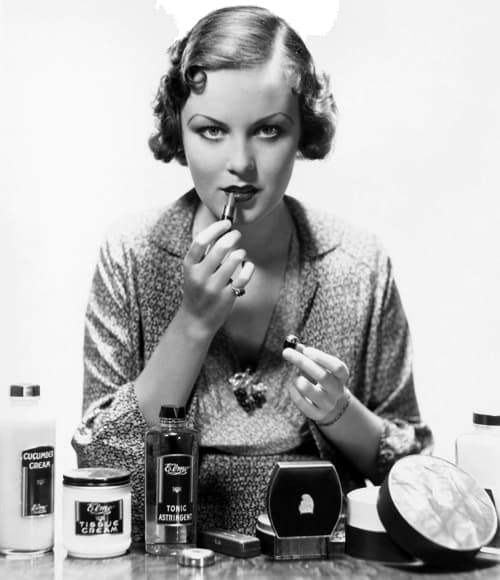
Above: Elmo Cucumber Cream (lotion), Tissue Cream, Tonic Astringent, Rouge, Kohl-Mo (mascara), Ra-Lo Face Powder, Ra-Lo Dusting Powder, and an unknown cosmetic. The model appears to be using an Elmo Jumbo Lipstick.
The increased demand for its products meant that Elmo soon needed additional manufacturing capacity. In 1936, it bought an abandoned three-storey factory from the Signature Hosiery Company at Tulip and Rhawn Streets, Philadelphia. Following its refurbishment, Elmo opened business there in 1937.

Above: 1937 Elmo factory.
Skin-care
Elmo added a number of skin-care cosmetics during the decade, starting with Elmo Melting Cream, and Elmo Muscle Oil in 1930.
From its description, Elmo Melting Cream (1930) appears to have been a type of liquefying cleansing cream, a type of cleanser manufactured by a number of cosmetic companies in the 1930s.
Melting Cream: “[A] liquefying cleanser, delicately fragrant, which when patted into the skin, penetrates the pores, dislodges all impurities, leaving the skin soft and clean.”
See also: Liquefying Cleansing Creams
Elmo Muscle Oil (1930), renamed or replaced by Elmo Toning Oil by 1937, was similar to products produced by other cosmetic companies. Muscle oils were supposed to firm the skin by building up facial muscles. They were applied around the eyes or over fine lines but could also be added to, or patted over, other face creams.
Muscle Oil: “[A] strengthening and penetrating vegetable oil especially formulated for persistent lines, wrinkles and sagging muscles in all types of skin.”
See also: Muscle Oils
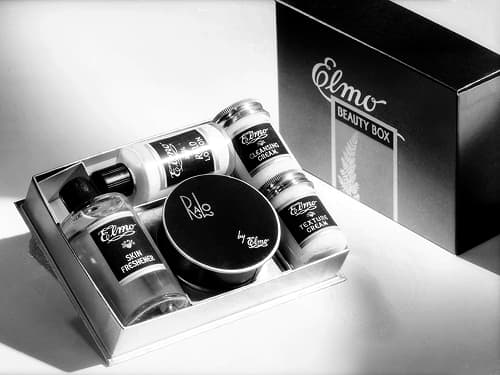
Above: 1934 Elmo Beauty Box containing Elmo Skin Freshener, Ralo Lotion, Cleansing Cream, Texture Cream, and Ralo Face Powder.
Other skin-care cosmetics added during the 1930s included: Elmo Skin Freshener (1932), a skin tonic; Elmo Hand Cream (1935); Ultrae Cleansing Cream (1935), for dry or sensitive skins; All-Weather Lotion (1937), a day cream to be used as a skin protectant; Special Purpose Cream (1937), an oil-rich emollient; and Special Nite Cream (1941), another oil-rich cream for use overnight.
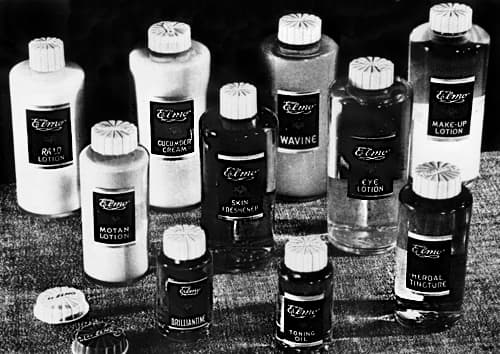
Above: 1937 Elmo cosmetics.
Back: Ralo Lotion, Cucumber Cream, Wavine, and Make-up Lotion.
Middle: Motan Lotion, Skin Freshener, and Eye Lotion.
Front: Rouge, Brilliantine, Toning Oil, and Herbal Tincture.
Skin Freshener: “[R]emoves all traces of cleansing cream, refreshes and tones the skin. A mild astringent that is recommended for a dry, sensitive skin.”
Elmo Hand Cream: “No oily effect. Quickly absorbed.”
Ultrae Cleansing Cream: “A soothing, deep-cleansing cream that brings a new, youthful softness to tired skin.”
All-Weather Lotion: “[A] light creamy emulsion that smooths away chapping, redness and roughness in all kinds of trying weather. Men like it as an After Shaving Lotion because it gives a velvety smooth finish.”
Special Formula Cream: “The result of fifteen years of intense laboratory research, compounded of rich, nourishing oils, it is recommended to soften and lessen lines around the eyes, prevent crepey neck and firm the contours of the throat.”
Special Nite Cream: “Its rich emollient oils help keep dry skin alluringly soft and smooth.”
Elmo recommended patting rather than massaging these cosmetics into the face.
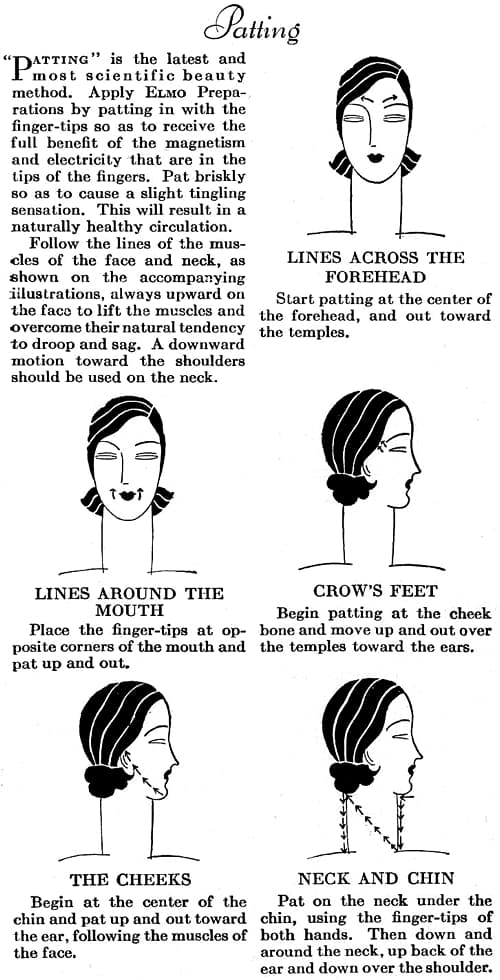
Above: Elmo Patting routines.
Also see the booklet: The Way to Loveliness by Elmo (c.1931)
In 1933, Elmo debuted a new clay mask, the Elmo Milk Pack, recommended as a ‘5 o’clock pick-up’ to be taken before going out for the evening. It came as a kit consisting of a powder and liquid to be mixed together before being applied. A spoon was included to help measure out the correct amounts.
Milk Pack: “A dewy fresh skin after a busy day is no mean accomplishment, but a stimulating Elmo Milk Pack will do the trick with the pat of a hand. It tightens, smooths, and clears.”

Above: 1936 Elmo Milk Pack. I presume its name came from powdered skim milk incorporated into the formula.
Sun products
In 1936, Elmo added Motan Lotion presumably coloured with the Mo-Tan shade that Elmo had introduced in the 1920s. This darkened the skin but may not have had any major protective effect. Elmo recommended it be used in conjunction with the Sunset shade of rouge and lipstick. Elmo Sunburn Cream, a lotion released in 1939, does appear to have contained some sort of sunscreen.
Motan Lotion: “For a gorgeous tan. Apply it liberally before exposing yourself to the sun. You will be agreeably surprised at the amazing result—an even coat of tan almost immediately.”
Sunburn Cream: “Gives a nice even tan. Avoids soreness and blistering.”
Make-up
Elmo added a number of new make-up items during the 1930s and made some attempt at extending its shade ranges.
Foundations and Powders
New foundations added during the 1930s included Ralo Lotion (1932) and Elmo Foundation Mist (1938), the later coming in two shades.
Ralo Lotion: “[A]n excellent summer powder base because it is non-sticky and because it protects and beautifies the skin.”
Foundation Mist: “[I]t will give your skin a velvety appearance and make your face powder adhere like magic.” Shades: Peach, and Sun Peach.
Elmo did not add any new face powders in the 1930s but increased the shade ranges of both the Ralo and Margo Face Powders. By 1936, each came in Flesh, Brunette, Beige, White, Nude, Baresque, Ivory, Motan, and Medar shades, the darker shades reflecting the growing interest in the pactice of ‘sun burning’, later known as suntanning.
Elmo Liquid Powder also had its shade range extended with the Nude shade added by 1936. By then, it also appears to have had a name change and/or reformulation, now being referred to as Elmo Make-up Lotion.
Make-up Lotion: “[R]eplaces face powder on occasions where it isn’t practical to keep retouching your make-up . . . excellent for the arms and shoulders because it won’t rub off.” Shades: Flesh, Brunette, White, Motan, and Nude.
Lipstick and rouge
In the early 1930s Elmo was retailing an Elmo Jumbo Lipstick, an indelible in two shades – Evening and Natural. By 1936, Elmo was selling two lipsticks, a more expensive Elmo Permanent Lipstick, which looks to have been an automatic, in Evening, Carnation, Dawn, Sunset, Natural, and Rose shades, and a cheaper Elmo Varsity Lipstick, aimed at a younger market, in Dawn, Carnation, Rose, and Natural.
In 1938, Elmo added the Dubonnet shade to its lipsticks selling them in three differently coloured cases.
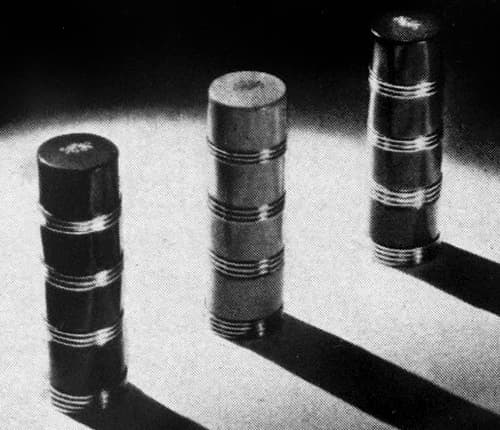
Above: 1938 Elmo Dubonnet Lipsticks in Royal Blue, Coral, and Dubonnet cases.
Elmo Dry and Creme Rouge also had their shade ranges extended by 1936. Elmo Dry Rouge, which had come in American Beauty, Carnation, Evening, and Rose shades in the early 1930s had Dawn, and Sunset shades added in 1936, while Elmo Creme Rouge, only sold in Evening, and Natural shades in the early 1930s now came in Evening, American Beauty, Dawn, Natural, and Sunset.
1940s
The 1940s was marked by a growing alienation between the two sisters that ended up in the courts. The fact that the two women were living in separate cities probably did not help. Margaret had remarried in 1938 to Charles Howard Moore, a bone specialist, and was now living in New York while Mary was still based in Philadelphia. The dispute was not resolved until 1949 when a settlement gave Margaret two-thirds of the company and Mary the other third.
Products
Most of the new lines introduced by Elmo during the 1940s were in make-up. The only new skin-care cosmetics added by Elmo in this period that I know of being a hormone face cream and hand lotion. The face cream contained 10,000 International units of hormone so stayed within the limits set by the American Food and Drug Administration (FDA).
Elmo Hormone Cream: “Use it regularly to help smooth away age lines, crepey textured skin. Natural hormones are absorbed, rich emollients smooth away dryness.”
Elmo Hormone Hand Lotion: “Carefully blended formula helps beautify and condition hands.”
See also: Hormone Creams, Oils and Serums
Make-up
From 1940, Elmo began describing its some of its make-up as ‘climatized’. This started with lipsticks when Elmo claimed to be adding ingredients to them to protect the lips from sun, wind and weather but also included Creme Rouge and Eyeshadow.
Elmo gives you a climatized lipstick especially prepared to apply smoothly and evenly and to aid in protecting your lips in this particular climate . . . Creme Rouge and Eyeshadow are Climatized too . . . In all fashionable shades.
(Elmo advertisement, 1940)
Elmo added some new lipstick shades in the years prior to America entering the Second World War including: Two-Lip Red, Indian Paint Brush, Navajo, and Pow Wow (1940); then Fire Coral, Fathom Red, and Attention Red (1941). Some shades may have been temporarily discontinued during the war as Elmo lipsticks came in Dawn, Natural, Rustic Red, Navajo, Paint Brush, Fire Coral, Fathom Red, Attention Red, and Dubonnet in 1944.
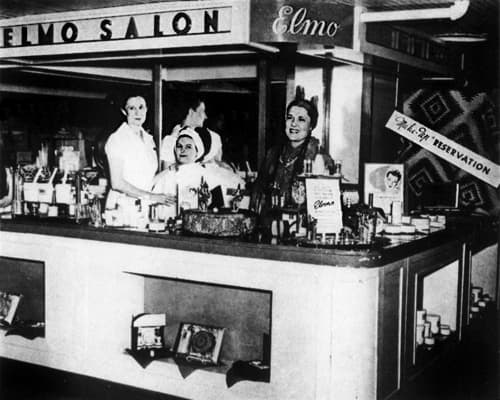
Above: 1940 Indian make-up shades being promoted at the Elmo counter at the John A. Brown Company, a department store in Oklahoma City. The woman on the right may be one of the Elmo sisters.
Lipstick shades added through until 1956 included Prism Pink (1945), Red Print (1946), and Gay Flare (1948) along with Candid Red, Closeup Red, Reel Red, Scarlet Bright which are regrettably as yet undated.
Photo-finish
The most important new make-up item Elmo introduced in the 1940s was Photo-Finish (1942), a copy of Max Factor’s astonishingly successful Pan-Cake Make-up, first sold to the general public in 1938. Like Pan-Cake, Photo-Finish was applied with a moist sponge and was sold in a plastic case.
Photo-Finish: “A flick of the sponge and the amazing new Elmo make-up is smoothed on, to stay for hours. Beautifies instantly. Helps cover those worry wrinkles and tiny blemishes.” Shades: Peach, Nude, Rachel, and Copper, with Beach Tan added later in the year and Brazil in 1944.
Also see: Pan-Cake Make-up
During the Second world War, Elmo also recommended Photo-Finish as a stocking substitute.
Photo-Finish has another use, too . . . it gives a beautiful sheer stocking effect to the legs . . . and it’s practical to the very dickens because it’s moisture repellant.
(Elmo advertorial, 1942)
Also see: Cosmetic Stockings
Additional lines were added to create a Photo-Finish Make-up range including: Photo-Finish Face Powder (1944), Photo-Finish Lipstick (1945), Photo-Finish Cream Make-up, Photo-Finish Make-up Remover (1945), Photo-Finish Cream and Dry Rouge, Photo Finish Eyeshadow, and Photo-Finish Mascara. Most of these make-up items came in six shades but unfortunately shade ranges are missing apart from Photo-Finish Face Powder which probably came in Peach, Nude, Rachel, Copper, Beach Tan, and Brazil. Elmo also added a night cream to the range, Photo-Finish Creme Royal.

Above: 1948 Elmo Photo-Finish Beauty Preparations.
Photo-Finish Face Powder: “Mist-light. Gives your skin a clear, fine-textured glow. Clings so well there’s no need to retouch and spoil it.”
Photo-Finish Lipstick: “[A] lipstick that will be as indelible on your lips as on the impressions of your public.”
Photo-Finish Rouge: “[L]ong-enduring rouge created in clear tones to emphasize natural color.”
Photo-Finish Cream Make-up: “[F]or dry or mature skin. Has no drying effects, conceals minor blemishes and lasts for hours and hours.”
Photo-Finish Make-up Remover: “Actually removes make-up thoroughly, gently, effectively—with one application.”
Photo-Finish Creme Royal: “Satiny, emollient lanolated night cream that smoothes, soothes and relaxes the skin.”
Initially, all Photo-Finish cosmetics were package in pink, plastic containers, many with a moulded pink bow on the lid, but some items were repackaged in brass after the Second World War. Elmo was very familiar with plastic. It had repackaged its Ralo Face Powder in moulded plastic in 1939 and did the same with Margo Face Powder in 1941, well before metal became scarce during the Second World War. The pink bow motif was not exclusive to Photo-Finish products and was also used on a number of other Elmo lines in the 1940s.
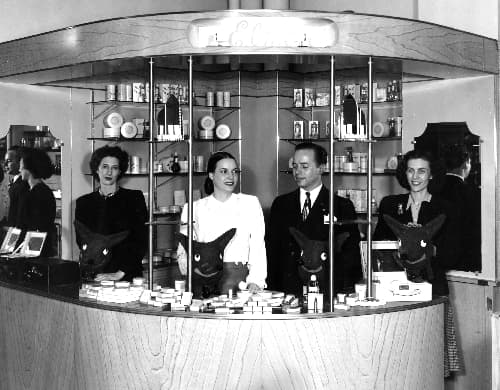
Above: 1946 Elmo stand at the W. A. Greene Department Store in Dallas, Texas.
1950s
After repackaging its hand and face creams in 1950, Elmo began adding a number of new lines. These included: a powder form of its Deo deodorant (1952); Photo Glo (1952), a liquid sheer make-up that did not require powdering; Photo-Sheen (1953), a liquid version of Ultrae Cleansing Cream which was sold in a squeeze bottle; and Doll Face (1954), a pressed cream powder that came in a pink plastic compact.
Photo Glo: “Unheard-of sheerness yet all flaws are hidden! Unheard-of translucence without an artificial look.” Shades: Peach, Rachel, Copper, and Brazil.
Photo-Sheen: “A lanolized liquid cleanser removes all traces of dirt and makeup.”
Doll Face: “This pressed powder has a fine cream makeup base blended in to soften your skin.” Shades: Ash Rose, Burnished Rose, Prism Pink, and Evening Rachel.
Elmo also introduced two new fragrances, Pretty Please (1953) and So Gay (1955), which were used in perfumes, colognes, bath oils, talcum powders, and dusting powders. These joined similar products created with the Honeysuckle (1946) and Going My Way (1947) fragrances released earlier.
End of the line
Mary’s death in 1953 may have triggered rumours that Elmo was going to be sold. This was vigorously denied by the company but a sale came three years later, the same year that Elmo, along with Revlon, Richard Hudnut, Helena Rubinstein and Yardley, finally settled their legal actions with the FTC that began decades early following the 1936 Robinson-Patman Act. All five companies agreed to cease offering advertising, displays and demonstrators to any of their customers unless they were available to all, or appropriate compensations were made.
Elmo’s sale in 1956 was to Apex Beauty Products, Inc., a company founded by Sarah Spencer Washington [1889-1953], a Black entrepreneur. Apex looks to have been more interested in Elmo’s proprietary knowledge than the range as they began an Elmo close of business sale in 1956 which went through until 1960 when it sold Elmo to Parry Laboratories.
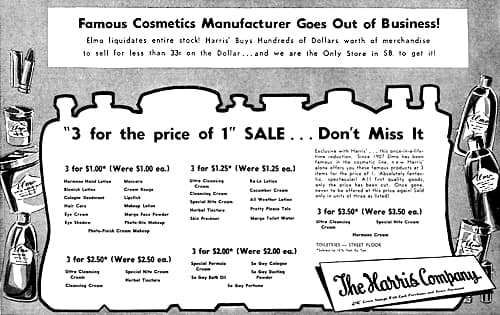
Above: 1957 Elmo liquidation.
Strangely, while closing the line down, Apex Beauty appears to have bought into the royal jelly craze of the 1950s, adding it to a version of Ralo Lotion.
Ralo Lotion with Royal Jelly: “It’s a rich, delightfully refreshing emollient for the face, neck, body . . . now with Royal Jelly added to impart a lovely youthful glow to your skin. Use as a day-long powder base, too . . . it gently lubricates and softens the most sensitive skin.”
See also: Royal Jelly
Donald D. Burr [1923-1990] of Parry Laboratories tried to revive Elmo but gave up after a year, selling Parry Laboratories – founded in 1958 to promote Myomist, an oral antiseptic – which now included Elmo, to E. A. Tracey Enterprises in 1961. Tracey Enterprises probably wanted to acquire Myomist rather than a cosmetics line and, as far as I can tell they did nothing with Elmo. This marked the end of the line for the brand.
Timeline
| 1908 | Elmo Sisters established. |
| 1910 | New Products: Dry Rouge; and Deo Cream Deodorant. |
| 1913 | Elmo Sisters incorporates. |
| 1919 | New Products: Ra-Lo Face Powder; and Margo Face Powder. |
| 1922 | New Products: Margo Masque. |
| 1925 | New Products: Cream Rouge. |
| 1930 | New Products: Melting Cream; and Muscle Oil. |
| 1932 | Elmo Sales Corporation established in Philadelphia. New Products: Ra-Lo Lotion. |
| 1934 | New York office opened at 350 Fifth Avenue. |
| 1935 | Elmo begins radio broadcasting in New York. New Products: Ultrae Cleansing Cream. |
| 1936 | Factory acquired in Philadelphia. New Products: Motan Lotion. |
| 1937 | Elmo Sales moves to Tulip and Rhawn Streets, Philadelphia. New Products: Special Formular Cream. |
| 1938 | New Products: Foundation Mist. |
| 1939 | New Products: Deo Stick Deodorant. |
| 1940 | New Products: All-Weather Lotion; and Climatised Lipstick. |
| 1941 | New Products: Special Nite Cream; and Margo Talcum Powder. |
| 1942 | New Products: Photo-Finish Cake Make-up. |
| 1944 | New Products: Photo-Finish Face Powder. |
| 1945 | New Products: Photo-Finish Lipstick; Photo-Finish Rouge; Photo-Finish Cream Make-up; and Photo-Finish Make-up Remover. |
| 1950 | Face creams repackaged. |
| 1952 | New Products: Photo Glo; and Deo Powder Deodorant. |
| 1953 | New Products: Photo-Sheen. |
| 1954 | New Products: Doll Face. |
| 1956 | Elmo sold to Apex Beauty Products. |
| 1960 | Apex Beauty Products sells Elmo to Parry Laboratories, Inc., New York. |
| 1961 | Parry Laboratories sold to E. A. Tracey Enterprises, Inc., New York. |
First Posted: 15th November 2021
Last Update: 17th March 2023
Sources
The American perfumer & essential oil review. (1906-1955). New York: Robbins Perfumer Co. [etc.].
Elmo, Inc. (c.1931). The Way to Loveliness by Elmo. Philadelphia, PA: Author.
The drug and cosmetic industry. (1932-1997). New York: Harcourt Brace Jovanovich [etc.].
Uris, A. (1969). The strategy of success. London: The MacMillan Company.
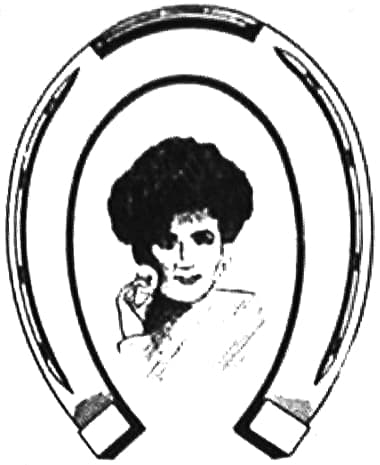
1908 Elmo Sisters trademark consisting of an image of Margaret Dryden surrounded by a horseshoe.

1911 Elmo Sisters Beautifier.
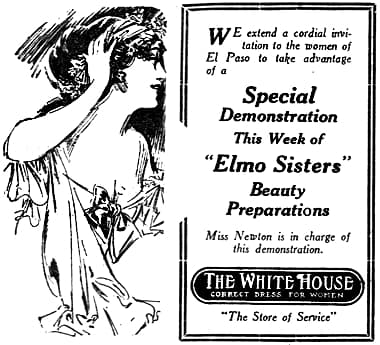
1912 Elmo Sisters.
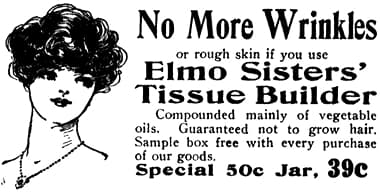
1912 Elmo Sisters Tissue Builder.
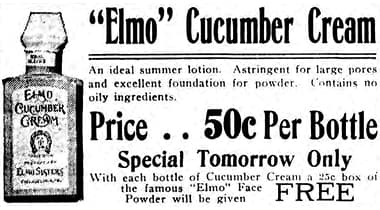
1914 Elmo Cucumber Cream.
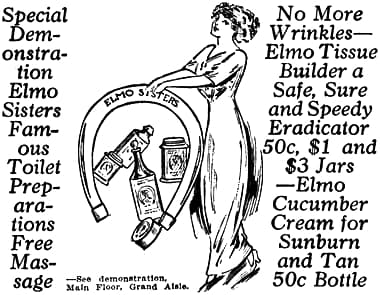
1914 Elmo Sisters.
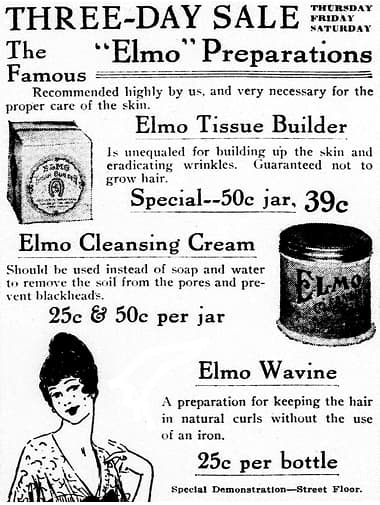
1914 Elmo Tissue Builder, and Cleansing Cream.
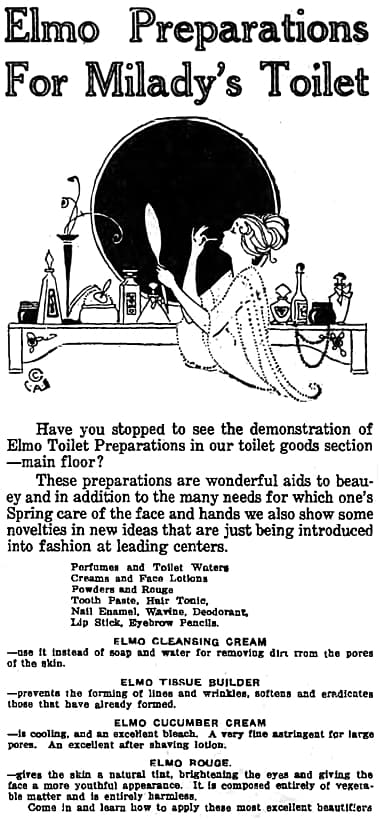
1920 Elmo Cleansing Cream, Tissue Builder, Cucumber Cream, and Rouge.
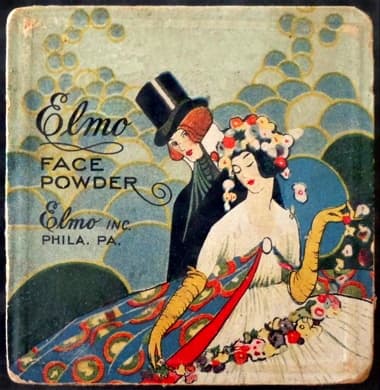
Elmo Face Powder.
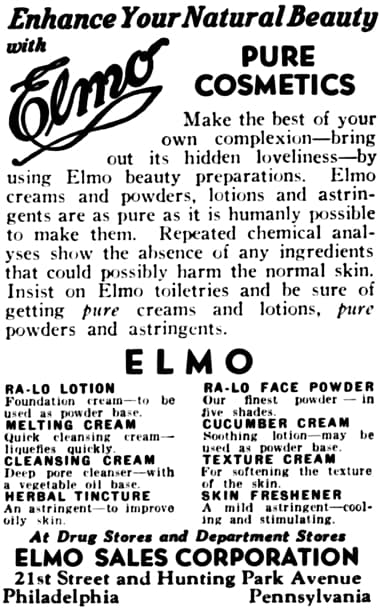
1934 Elmo Sales Corporation.
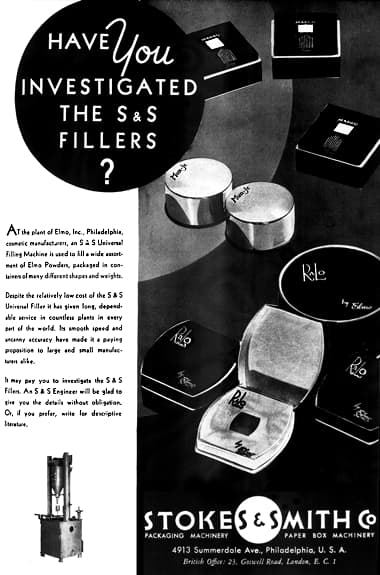
1935 Stokes & Smith trade advertisement featuring Elmo Mur-Je, Margo, and Ra-Lo Face powders.
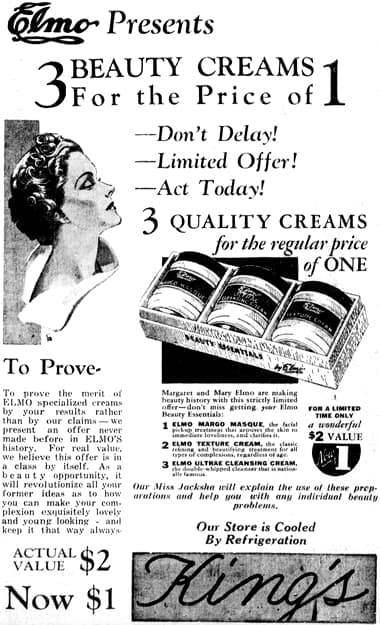
1936 Elmo Margo Masque, Texture Cream, and Ultrae Cleansing Cream.
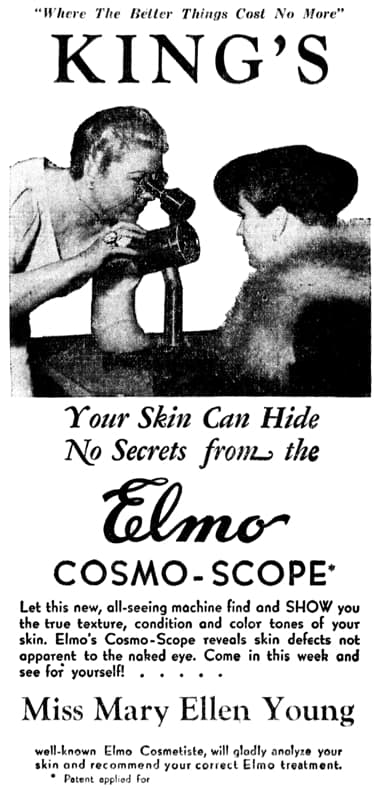
1936 Elmo Cosmo-scope.
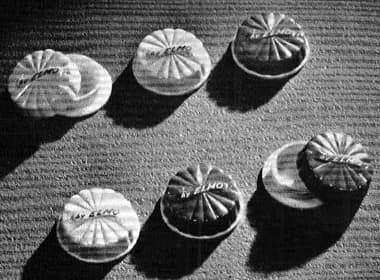
1937 Elmo Paste Rouge in new Plaskon containers.
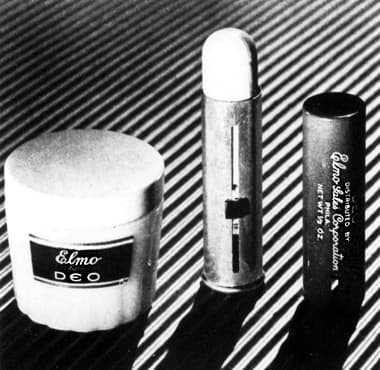
1939 Elmo Deo Cream and Stick Deodorants.
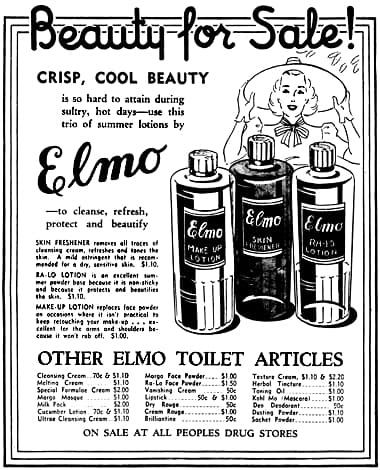
1939 Elmo Toilet Articles.

Ralo Face Powder in a plastic box introduced in 1939.
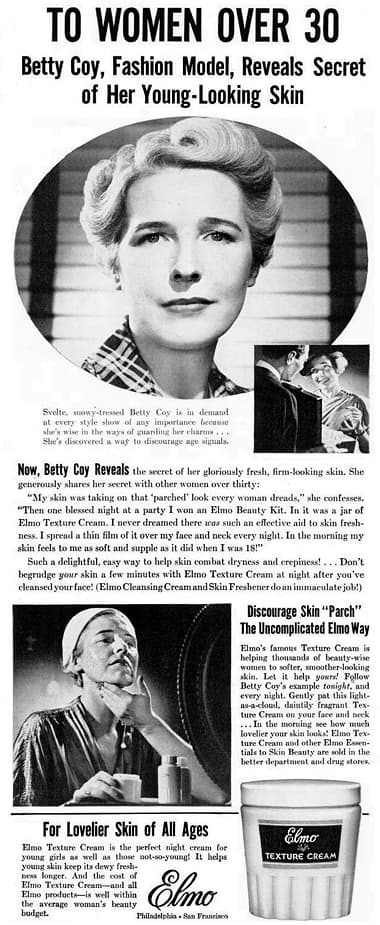
1939 Elmo Texture Cream.
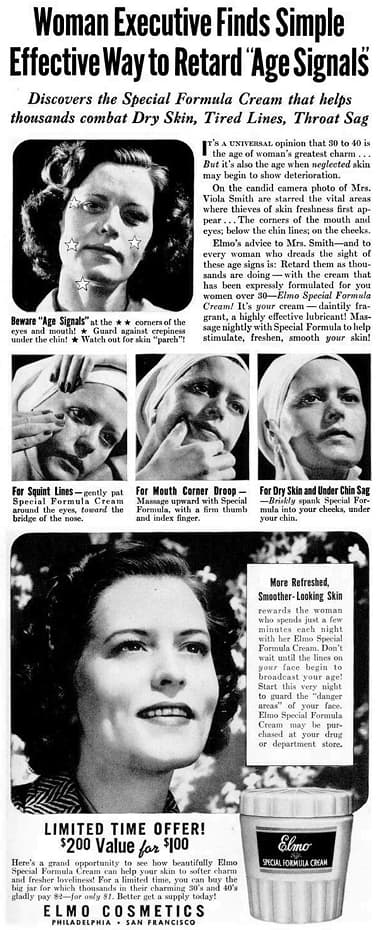
1939 Elmo Special Formula Cream.
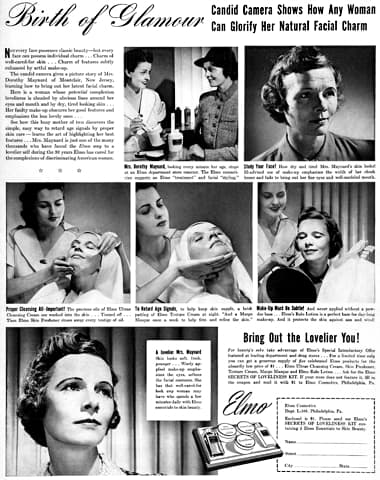
1939 Elmo ‘Birth of Glamour’
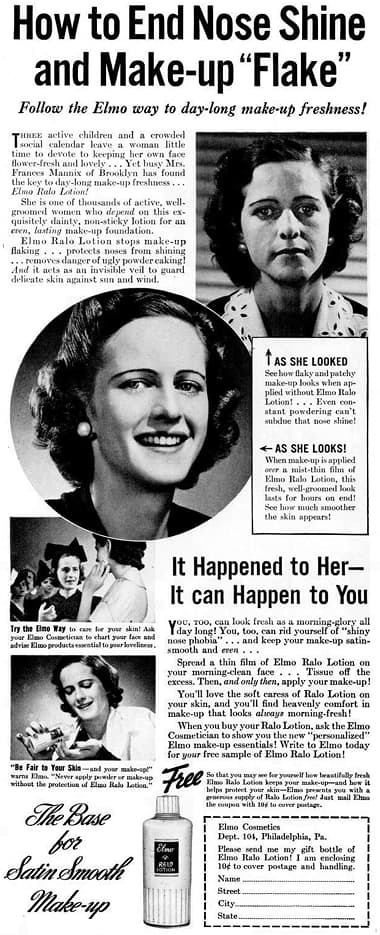
1939 Elmo Ralo Lotion.
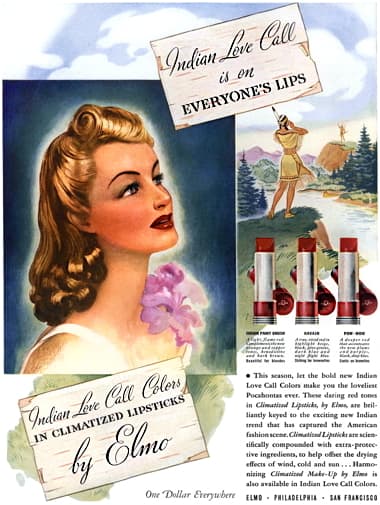
1940 Elmo Indian Paint Brush, Navajo, and Pow-Wow Lipsticks.
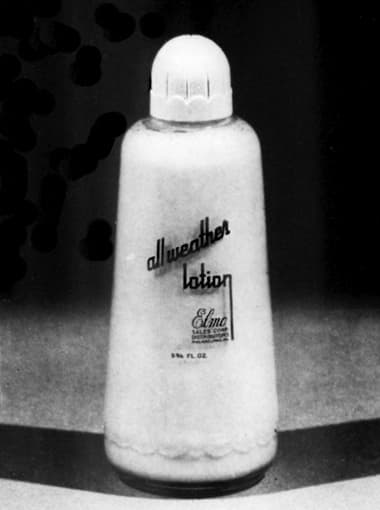
1940 Elmo All-Weather Lotion.
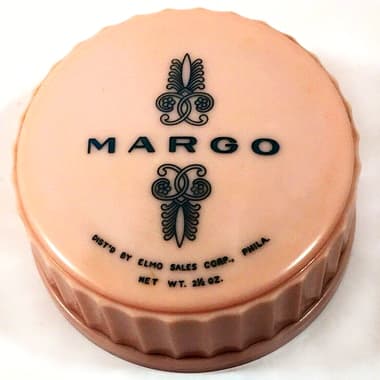
Margo Face Powder in packaging introduced in 1941. It was available in Brunette, Beige, Nude, Dark Brunette, Peach, Sun Peach, Pastel Navajo, and Sea Nymph.
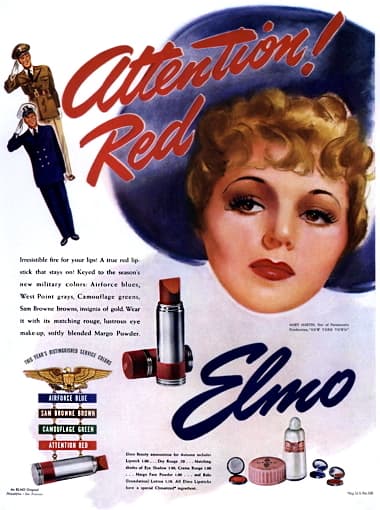
1941 Elmo Attention Red Lipstick.
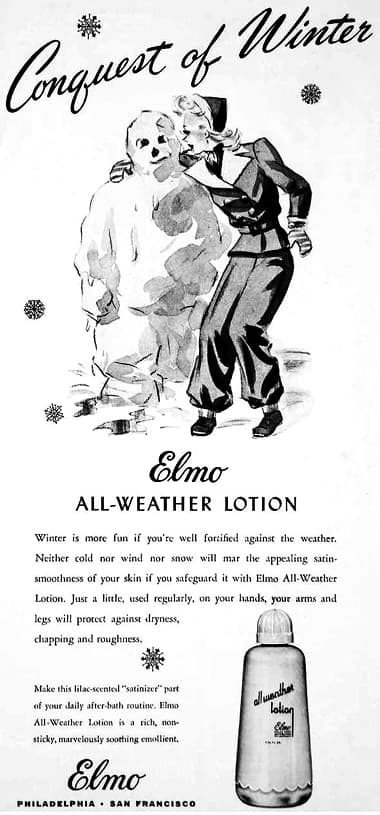
1941 Elmo All-Weather Lotion.

1941 Elmo Fire Coral and Fathom Red.

1942 Elmo Margo Face Powder, Dusting Powder, Talcum Powder, and Eau de Toilette in packaging first used in 1941.
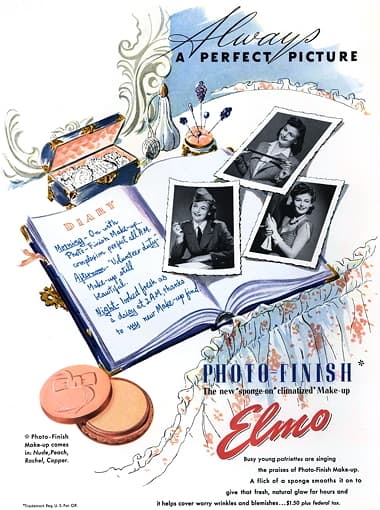
1942 Elmo Photo-Finish.
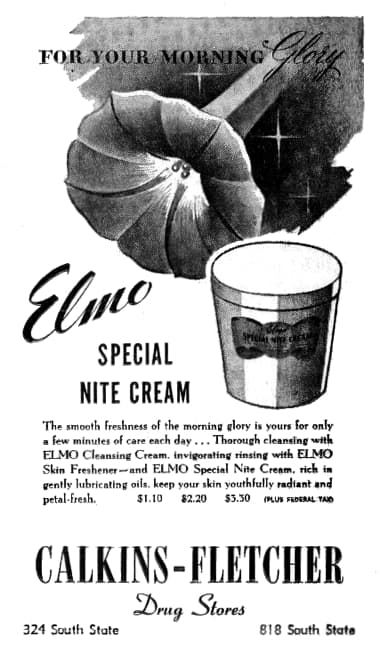
1943 Elmo Nite Cream.
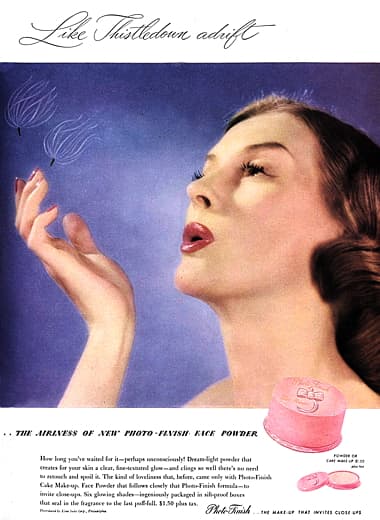
1944 Elmo Photo-Finish Face Powder.
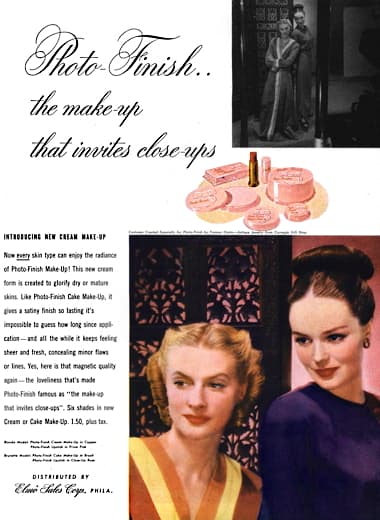
1945 Elmo Photo-Finish Mascara, Lipstick, Face Powder, Rouge, Cream Make-up, and Cake Make-up.
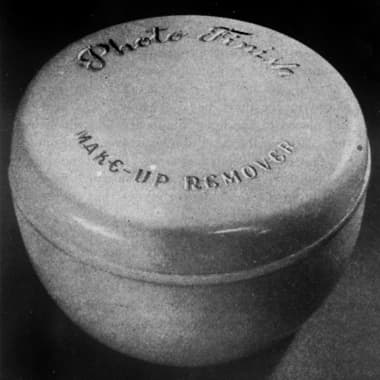
1945 Elmo Photo-Finish Make-up Remover.

1945 Elmo Photo-Finish Lipstick.
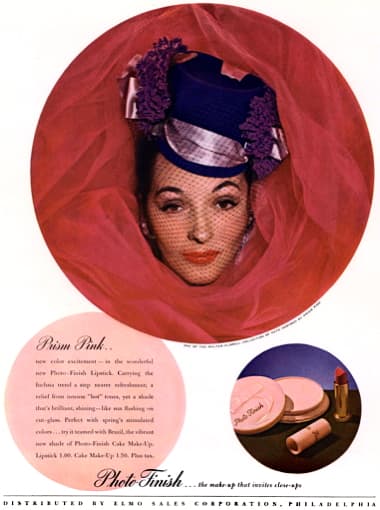
1945 Elmo Prism Pink.
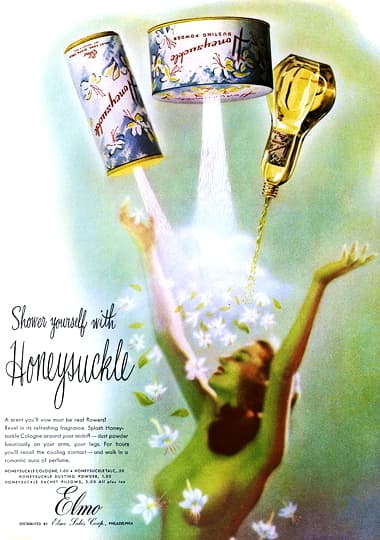
1946 Elmo Honeysuckle Talcum Powder, Dusting Powder, and Cologne in packaging first used in 1941.

1946 Elmo Photo-Finish cosmetics in moulded Plaskon plastic.
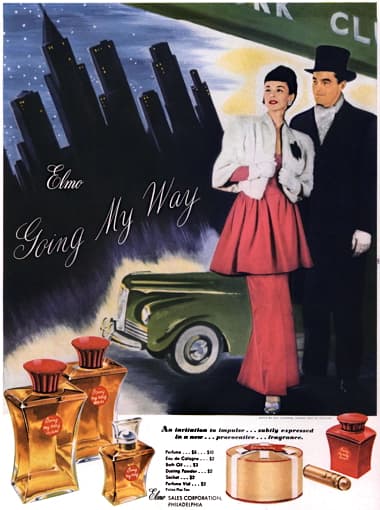
1947 Elmo Going My Way line.
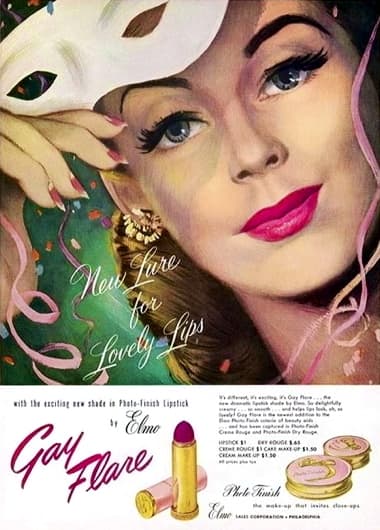
1948 Elmo Gay Flare Photo-Finish Lipstick, Dry Rouge, Cream Rouge, Cake Make-up, and Cream Make-up.
